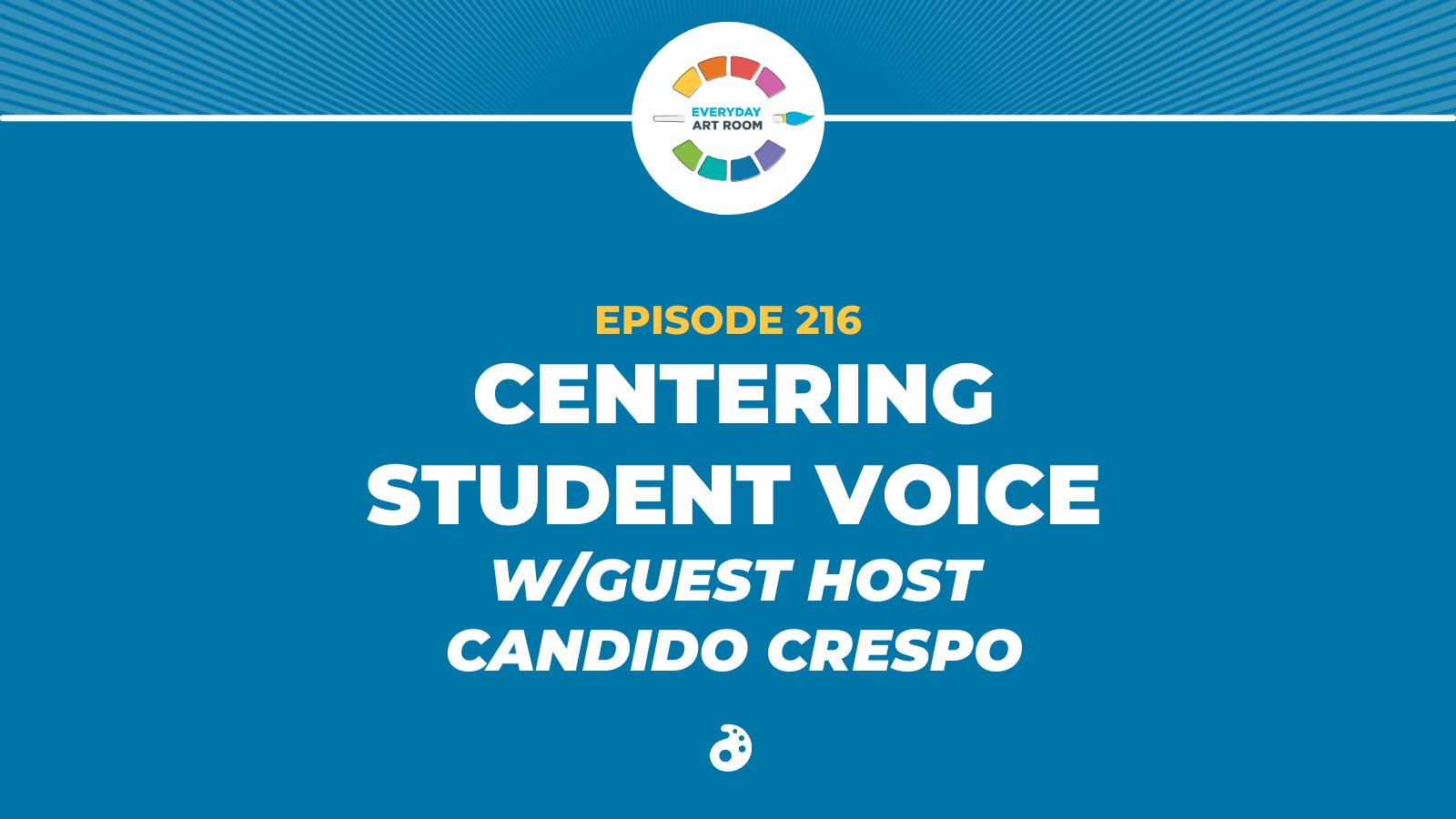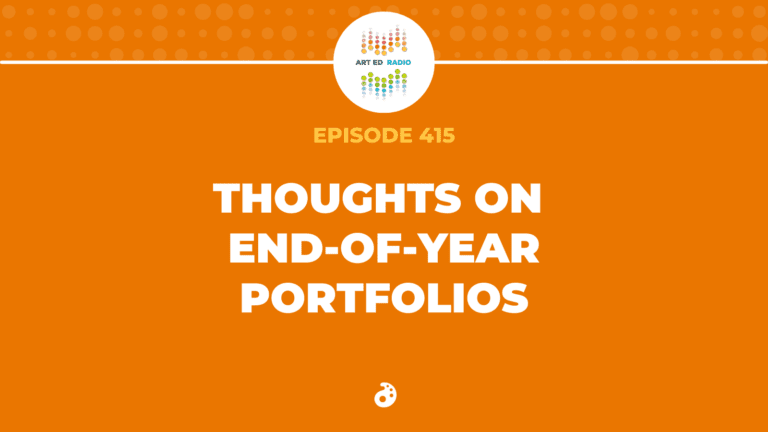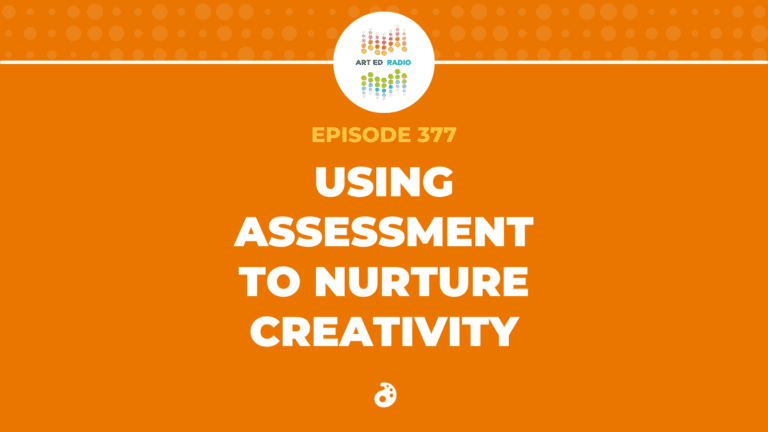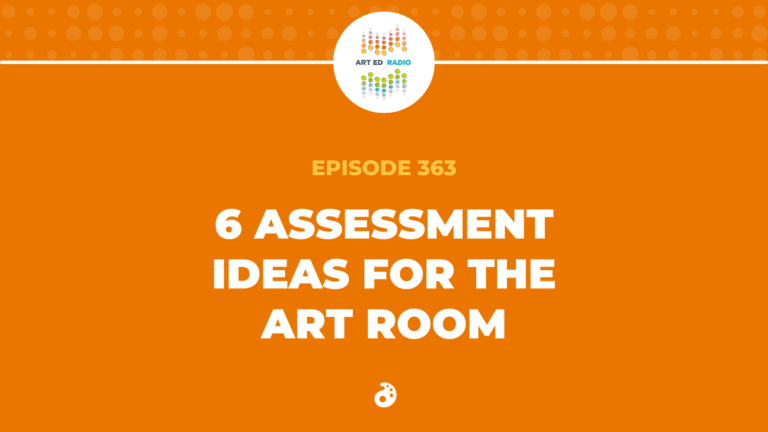In his first of two episodes as guest host, Candido Crespo welcomes art educator Paula Liz to discuss how we can center student voice in our classrooms. Listen as their conversation covers how we can provide opportunities for our young artists, why everyone needs to share their work, and the ways in which we can advocate for ourselves and our students. Full Episode Transcript Below.
Resources and Links
- Find Paula Liz and Anti-Racist Art Teachers on Instagram
- Follow Candido on Twitter and Instagram
- Building Confidence with a Student-Centered Drawing Library
- A Powerful Painting Project that Amplifies Student Voice
- Black Student Truth: A Series to Share Student Voice
- Apply to be an AOEU Podcast Host!

Transcript
Candido: Long before I understood the power of collaboration between students and teachers, and the benefits of being the guide on the side, I was guilty of constantly being the sage on the stage. I would instruct and not provide space for my students to share ideas that could give new life to the classroom environment or freshen up lessons. To be completely honest, there’s a lot more room for growth, still.
I called in a friend and leader in this conversation, Paula Liz, an incredible art teacher that focuses on exploring identities and centering student voice. I have questions, she has answers. Let’s get into it. This is Everyday Art Room, and I’m your host, Candido Crespo.
Paula Liz, thank you for joining us. I was wondering if you could please introduce yourself. What is your education teaching background in brief?
Paula: Hi, I’m so glad to be here. My name is Paula Liz. I have a master’s in art education from Maryland Institute College of Art, and I have over 12 years teaching experience at public schools, independent schools and charter schools in New York City, Texas, Washington, D.C., and now in Maryland.
Candido: Okay. In there lies all the experience we need to discuss what we are going to today. You had a conversation on Instagram a while back that focused on student voice. What does it mean to center student voice?
Paula: For me, art is really all about self expression, and if you’re not centering student voice, then the art that they’re creating is not authentic to who they as artists. But most importantly, you’re teaching them that their voice doesn’t matter and that they’re incapable of creating change. Traditionally, teachers have been seen as the sole proprietors of knowledge in the classroom, but the truth is that our students hold valuable knowledge and they have so much to teach us and each other as well.
Unfortunately, more often than not, students are expected to simply act as these receptacles of knowledge. As Paolo Friere describes, it’s this traditional banking concept of education where the teacher holds all of the knowledge and the power in the classroom, and they’re simply just depositing that into students. In education, it really reinforces the status quo and it reinforces complacency and prohibits us from questioning or even challenging our own unjust realities.
What we need to be doing is providing our young artists with opportunities to express their feelings, to explore their thoughts and to share their own stories, because ultimately our voices actions have the power to create change, and we can provide space for our students to use their voices to speak up about issues that are important to them, and also to learn ways to take action no matter how small those actions might seem.
Candido: All right. I want to come back a little later to something that you answered there towards the end. But I think before we even go there, how do you initiate conversations that center student voice? I think that’s something that I would definitely work on.
Paula: I just ask questions. Also, just asking those questions and not leading the conversation, but rather guiding it. Oftentimes in art, we focus on the product and having to constantly create things, and we need to remember that we don’t have to leave the art room with these completed works of art every time. Even though my classes range from only 35 minutes to 55 minutes, there are some days when there actually is minimal art making actually happening. But ultimately what the students take away from the conversations we have is oftentimes so much more meaningful and impactful. Also, knowing that you can engage in conversations and dialogue during the art making process as well. It doesn’t need to be this silent studio to be a thriving studio.
Candido: I think in a prior conversation, you’ve mentioned that sometimes you let the students lead the conversation. Would you just ask the question and then just let them take it away? How does that work?
Yeah. Oftentimes I will ask the question and then let that let them lead it. Oftentimes, I can give an example. Last year, during distance learning, they were making these digital posters where they actually used their art and their words to express their feelings about a cause that was important to them. We initially began with the self-reflection of the questions, giving them time to process the questions themselves forehand before engaging in a full classroom dialogue. Some questions that I asked them were, what change would you like to see in the world?
How can your voice change the world? Why is it important to use your voice? How can you inspire others with your voice and how can you use your voice to create a more just society? Just asking those questions, and again, no two classes are ever the same. I’ll ask the same question to multiple, for example, fifth grade classes, and every class ends up taking a different direction. I feel like I learn so much from my students in those moments and they’re learning so much more from each other as well. I feel like it is a lot about more that guiding rather than that leading.
Candido: Sure. Sure. I think this is a good place to go back to something that you mentioned earlier. You said because ultimately our voices and actions have the power to create change. Have you found yourself or find the students to be creating work that is creating change? Having the conversation, the students are producing the work, have you seen any results in the community because of that?
Paula: Yeah. I know, for example, when doing … We did a unit where we talked about the importance of recycling and the impact of plastic on the environment, and students took it upon themselves after this conversation we had in classroom on their own, they created their own campaign, completely unprovoked by me, but they just decided to make their own posters to hang around the community. They actually organized a bake sale where they donated all of the money to, I believe, the Marine Mammal Foundation.
They were so inspired by this conversation and dialogue that was happening in the class that they took it upon themselves to take that action and to do this campaign and organize the whole bake sale and raise all of the money and everything. That’s just one example.
Candido: Right. Wow. Okay, that’s definitely impactful. This idea is definitely more like sharing the … I’m sorry. Sharing as an exchange instead of lecturing seems to be a very productive way to conduct the classroom. When did you first decide or realize that there was potential there?
Paula: I think for me it was personally because growing up … I was born in Puerto Rico. My first language was Spanish. In school, I always felt uncomfortable speaking up and speaking out, and I often felt that my voice wasn’t valued. The times that I did speak up, I felt like I was silenced. Growing up, that had a really big impact on me and who I was. When I became an educator, one of the main things I wanted to do was to empower my students to speak up and to know that their voice and their opinion does matter, and that they are important and that they can make an impact and a change in this world because that was one of the things for me personally that had that biggest effect on me. That’s just what I want to instill.
Candido: All right. That’s great. Can you actually walk us through a lesson that exemplifies centering student voice?
Paula: Yeah. I can think about just … There’s a couple. I started talking about it earlier, but last year during distance learning, my third group fifth grade artists, I asked them to make this digital poster campaign. We actually looked at some of the artwork created on amplifier.org. If you’re not familiar with them, a lot of … It’s a nonprofit design lab and it uses art to amplify these important movements and current events in our time.
We were able to look at that work of different artists and see how they were able to use a combination of both art and words to convey a message to provoke change. We started off by asking those questions that I had mentioned earlier, those self-reflection questions. What change would you like to see? How can your voice change the world? And having that classroom conversation to start brainstorming what it is that they care about and what’s important to them.
We also looked at and learned about a lot of different artivists such as Ai Weiwei, Favianna Rodriguez. Also, youth activists, Greta Thunberg, for example, so that they’re able to see how both artists and other kids their age have actually been able to use art and use their words and actions to create this change, to really show them that it is possible. From there, they … Again, this was during distance learning. We used digital program and they made these digital posters.
The really great thing about it is that through those posters, we were able to engage in a lot of really great dialogue, a breadth of different topics. We talked about racism, police brutality, Black Lives Matter movement. I live currently near Washington, D.C., so some of my students were talking about the protests. Some of them had actually taken part in them. It was really a lot of rich conversation that was happening during this project because I had them, throughout the project during the brainstorming part and also at the end, sharing their work and sharing their thoughts.
Really giving them that space to find their voice and to also begin to grapple with what it was that they were seeing happening in the world around them. I thought that that was a really great lesson and a way to start to talk about certain topics that people tend to avoid, and allowing them to feel comfortable having those conversations and providing that space to have that dialogue.
Candido: Okay. If I can interrupt you there, you mentioned the students sharing. I guess it’s one thing for students to share maybe their thoughts or feelings, it’s another for them to share their work. How are students receptive to conversations about one another’s work in that exchange?
Paula: Yeah. I think for me, I start in kindergarten. Sharing and presenting the work is part of that artistic process. Starting it very young, right? Just that ability to have conversations about your work with others I think is really important, especially as a visual artist. I know when I was in college, I felt that I learned the most from my peers. Right? Having those class critiques I thought was really, really influential and important to me, and I wanted to find ways to bring that into the elementary art room. Because oftentimes the word critique has this negative connotation. Trying to get them used to the fact that critique in this conversation is actually just a way to reflect on and grow and that it shouldn’t be seen as a bad thing.
Candido: Okay. These conversations sometimes can take five minutes, sometimes they can take 40 minutes. What are your feelings about conversations taking up studio time?
Paula: I think for me, I don’t see an issue with it because ultimately they’re still learning and they’re learning through the process of art. Art, again, doesn’t always have to be about making. I think about … Especially that initial brainstorming at the beginning of projects. Most of my projects, at minimum, take 10 weeks, if not more, before they actually have a finished created final work of art. It’s over a much longer course period of time, but it allows them that opportunity to really reflect and have those dialogues and reflections, which I think is an important part of the process of just being an artist in general.
Candido: Okay. This just came to mind. There are new teachers entering the field every year, and some of them may very well want to address social justice in the classroom but are hesitant. Any tips you can give a new teacher on how they can do social justice into the classroom?
Paula: I think some tips would just be to use contemporary art as a way to do that. Showing students the work of artists who are creating work in response to many of these social justice topics, having those conversations more explicitly. For example, talking about artivists like I had mentioned earlier, showing different video clips of the artists speaking and talking about their work. I talk about with my students with Ai Weiwei.
I think it’s called Remembrance, his series piece where he had the backpacks that represented all of the students that had died in the earthquake after the Sichuan earthquake. Having them see that and see how art was used as a way to bring awareness to something that they maybe weren’t aware of before. Again, yeah, just using contemporary art and artists is that entry point.
Candido: Okay. During these conversations, have you ever found yourself, I guess, not so much shocked, but surprised by some terminology or a concept that a student has raised that you needed to address to the whole class? This would be easy to come up if you started trying to address Black Lives Matter movement in the classroom. Yeah. Any situations where you have to like, “Okay, class. Let’s talk about this thing?”
Paula: I can think of a few.
Candido: Yeah. I’m sure.
Paula: Well, for one, I did have … You gave the example of Black Lives Matter. There was a student that said, “Well, what about all lives matter?” Using that as an opportunity to discuss and unpack, well, why do some people find that term to be offensive? Having that dialogue and conversation with the students, and they were actually very receptive to it because they were like, “I hadn’t thought about that before.” Just again asking questions back to them, instead of just saying. Because I don’t want to tell them, “Oh, you can’t say all lives matter.” Right?
Candido: Right.
Paula: It was just a question back to them. Again, guiding those conversations and guiding their thinking without leading it, for me, is what I do in the classroom.
Candido: Okay. I’m wondering, how do you envision a faculty and staff school system that continues to center student voices outside of your art room?
Paula: I think that ultimately what we need to do is just reevaluate the whole focus of what school is and the point of school, especially with standardized testing, because standardized testing in this traditional banking concept of education just reinforces to students that there’s only one right answer, when really what we need to be doing is empowering our students to think beyond that. What other answers could there possibly be?
Giving them that real voice and real choice in their own education and providing them with more autonomous spaces that allow them to really learn from one another. That also partly means that you’re learning to let go of control. Especially as educators in the classroom, we tend to want to control things. Giving up some of that control and power and knowing that you’re learning with your students as well, I think is really important.
Candido: Okay, I’m going to sound like a cynic, but you do all this work inside of the art room. A student goes into another core subject, that teacher is a super lecturer and their voice is silenced. Have you ever had to address that, both for the student or ever had the conversation with other faculty and staff members?
Paula: I don’t think I have ever had that conversation just because I don’t enter many other of my colleagues’ workspaces, but … Yeah.
Candido: That’s fine. Do the students ever come back to you and tell you maybe examples of, I guess, subjects that they can’t be so expressive? Traditionally speaking, art is a place where students can come and be self-expressive, but it shouldn’t be the only one, especially if we’re pushing creativity into these other subject matters. I’m just wondering, for somebody who is doing all this work such as yourself, at what point are we receiving the support as art teachers that maybe math teachers want support from us in helping them teach shapes and geometry? I’m wondering if you have any ideas of how we can start to address that as art teachers in our own advocacy and saying, “Hey, we need this from you in addition to what you need from us.”
Paula: I think for me, just in terms of, I guess, with advocacy, because a lot of times as an elementary art teacher, when I enter a new school, I find that the initial expectation is that the students are creating very cute artwork that can be hung up and taken home week after week, so focusing on that production aspect. One thing that I really advocate for and that I do notice follows through within all of their classes is for them to understand and appreciate that they have that creative ability and that that’s what they should be doing.
Really encouraging them to slow down especially. We live in such a fast-paced world. Because we slow down and have these conversations and don’t rush and think about the end product, I’ve had teachers approach me and say, “Oh, I noticed today when we were writing, they were talking about, ‘Oh, we just need to slow down and take our time and think about it,'” and that that translates into these other subjects. Because art isn’t just about teaching skills and techniques. It is about so much more. It’s just about a way of thinking and expressing and being that I think can transcend multiple subjects.
Candido: All right. We can’t go any further in this conversation without a little plug for what you have co-founded, an amazing organization, Anti-Racist Art Teachers. Can you tell us how centering student voice has played a role in that organization?
Paula: Well, also it’s not quite an organization. Really it’s just a group, a collective of art educators of the global majority across the country that we volunteer and contribute our time into maintaining the website and putting together resources, but ultimately with an ABAR, anti-bias anti-racist lens, it really needs to be rooted in a liberatory art practice, a liberatory educational practice.
You can’t have that liberatory creative space without centering student voice because ultimately what it’s about, we live in a society that has injustice and inequality, and in order to change anything, we need to create that change. In order to create that change, we first need to envision and imagine that change. It’s important that we’re, again, centering and empowering our students to have their own vision of what they see a better future being and then giving them the tools for them to speak up and take action once they get older.
Candido: Great. I can’t thank you enough for sharing these thoughts, examples of lessons and some new ways, new framing for how we should be instructing our students moving into the future. Thank you once again, Paula Liz.
Paula: Thank you.
Candido: I think the best way to follow up that conversation is with some honest self-reflection. If you want or are trying to create a student-centered art room, are you taking into consideration some of the ideas that Paula Liz has shared with us? I want to say thank you once again to Paula Liz for offering us so much to consider and act upon. If you aren’t already, please follow everything she and the Anti-Racist Art Teachers are doing at antiracistartteachers.org.
If you want more resources, you can check out articles available on the AOEU website, such as How to Build Confidence with Student-Centered Drawing library by Lindsey Moss, A Powerful Painting Project that Amplify Student Voice by Matt Christensen, and The Black Student Truth: A Series to Share Student Voice by Abby Schukei. Thanks for listening to Everyday Art Room. I hope you’ve learned enough to want to learn more. Catch you next week.
Magazine articles and podcasts are opinions of professional education contributors and do not necessarily represent the position of the Art of Education University (AOEU) or its academic offerings. Contributors use terms in the way they are most often talked about in the scope of their educational experiences.



